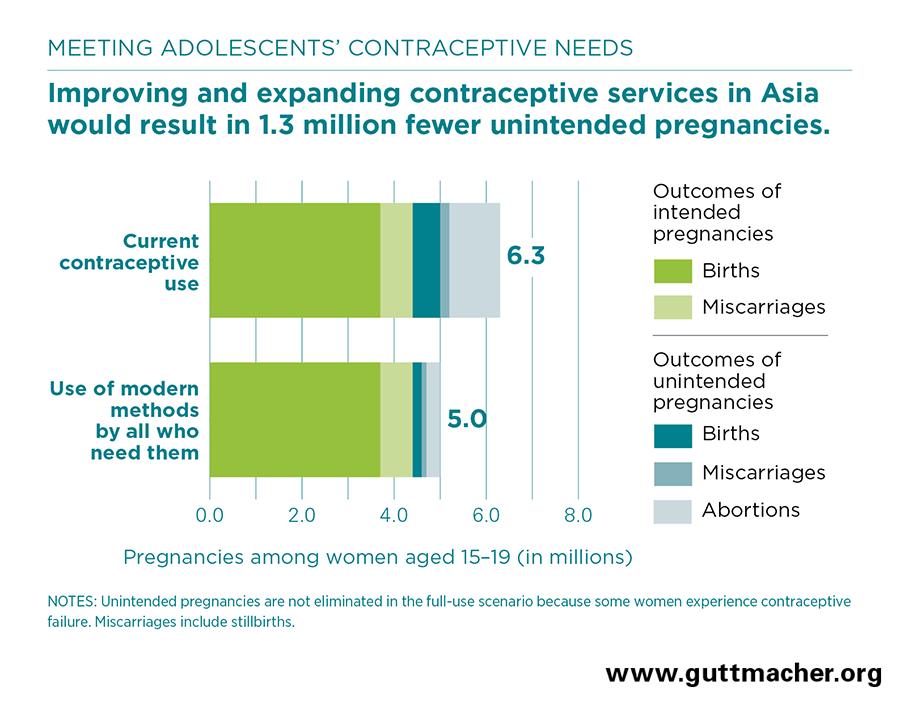Why preventing unintended pregnancy is critical
- Improving adolescents’ sexual and reproductive health, including preventing unintended pregnancy, is essential to their social and economic well-being.
- Complications of pregnancy and childbirth continue to lead to preventable deaths and ill-health among 15–19-year-old women in developing regions.1
- Adolescent childbearing is associated with lower educational attainment among mothers, and it can perpetuate a cycle of poverty from one generation to the next.1
- Almost one-third of pregnancies among adolescents aged 15–19 in Asia* are unintended,1 and more than half of these end in abortion.2–4 More than half of these abortions are unsafe.
Adolescents’ need for contraception
- Among the 124 million women aged 15–19 in Asia, 10% (12.2 million) need contraception because they are married, or are unmarried and sexually active, and do not want a child for at least two years.
- Of these 12.2 million adolescents, 38% (4.6 million) are using modern contraceptives. The most common method is the pill, followed by the male condom and injectables.
- The other 62% (7.6 million) are not using a modern method; these adolescent women have an unmet need for modern contraception. Among these women, four-fifths are using no method at all, and one-fifth use traditional methods, which are less effective than modern methods.
- Younger adolescents aged 15–17 generally have higher unmet need than do those aged 18–19.1
- Sexually active unmarried adolescents wanting to avoid pregnancy have higher unmet need than do married adolescents aged 15–19 (77% versus 57%).
- Among Asia’s subregions, unmet need is highest in Oceania and Western Asia, where 74% and 68%, respectively, of sexually active adolescents who want to avoid pregnancy are not using modern contraceptives.
- Young Asian women often report several reasons for not using contraception despite wanting to avoid pregnancy: infrequent sex; not being married; concerns about contraceptive side effects; breast-feeding or not having resumed menstruation after a birth; and their own, their partners’ or others’ opposition to contraception.5
Cost of meeting contraceptive needS
- Based on 2017 estimates, the annual cost of providing contraceptive services to 4.6 million women aged 15–19 in Asia who use modern contraceptives is $61 million. This averages to $13 per user annually.
- Service costs include direct costs for contraceptives, related supplies and health worker salaries, as well as the indirect costs of management functions, construction and maintenance of facilities, information and education activities, and other types of program support.
- If services were improved for the 4.6 million adolescent women currently using modern contraceptives, costs would increase from $61 million to $67 million. Examples of improvements that would benefit adolescents include better contraceptive counseling and follow-up, consistent availability of a range of modern methods and providers who are trained to work with adolescents.
- If the 7.6 million adolescent women with unmet need were to use the same mix of modern methods as current users and receive improved services, total costs for current and new users would be $170 million each year, an increase of $109 million annually.
- The expanded and improved services for all 12.2 million women who need them would cost $14 per user annually. Put differently, the annual cost per capita in Asia would be six cents.
Benefits of meeting all contraceptive need
- Increased use of modern contraceptives by adolescents wanting to avoid pregnancy would prevent unintended pregnancies, save lives and improve health.
- If all adolescent women who need modern contraceptives were to use them, unintended pregnancies would decrease by 1.3 million per year (66%), and total pregnancies would decrease from 6.3 million to 5.0 million per year. This would result in 411,000 fewer unplanned births; 693,000 fewer abortions, of which 385,000 would have been unsafe; and 151,000 fewer miscarriages and stillbirths from unintended pregnancies.
- Maternal deaths—those due to complications of pregnancy and childbearing—among women aged 15–19 would drop from the current level of 7,800 per year6 to 6,400.
Recommendations
- Meeting adolescent women’s contraceptive needs requires policies and practices to end child marriage, prevent sexual abuse and coercion, increase girls’ education, empower girls and women, and provide comprehensive sexuality education and high-quality contraceptive services.
- Boosting the level of education girls receive increases their ability to make autonomous decisions. Studies show that sexually active adolescents who are in school are more likely than those not in school to use contraceptives.1
- Engaging young men in sexual and reproductive health programs can help bring about more gender-equitable attitudes.
- Adolescents need access to medically accurate and complete sexual and reproductive health information before they are sexually active. This information should be age-, developmentally and culturally appropriate. Policies and programs, including comprehensive sexuality education, should be in put place that address this need.
- The most effective approaches to providing sexual and reproductive health services to youth include a combination of health worker training; facility improvements geared toward welcoming adolescents and protecting their privacy; and information dissemination through schools, communities and the media.1
- The counseling provided with contraceptive methods must be strengthened. All adolescents need correct information about the likelihood of pregnancy, choices of contraceptive methods, information about possible side effects, and support in switching methods when desired.
- Contraceptive services must be provided in a way that protects young women’s rights to voluntary, informed and confidential contraceptive choice.
